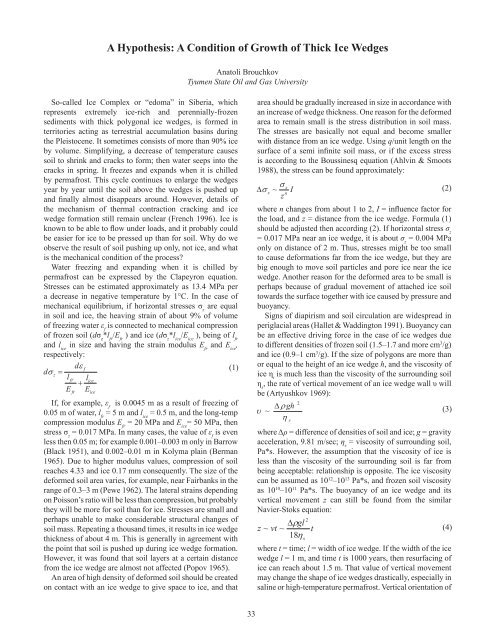Ninth International Conference on Permafrost ... - IARC Research
Ninth International Conference on Permafrost ... - IARC Research
Ninth International Conference on Permafrost ... - IARC Research
You also want an ePaper? Increase the reach of your titles
YUMPU automatically turns print PDFs into web optimized ePapers that Google loves.
A Hypothesis: A C<strong>on</strong>diti<strong>on</strong> of Growth of Thick Ice WedgesAnatoli BrouchkovTyumen State Oil and Gas UniversitySo-called Ice Complex or “edoma” in Siberia, whichrepresents extremely ice-rich and perennially-frozensediments with thick polyg<strong>on</strong>al ice wedges, is formed interritories acting as terrestrial accumulati<strong>on</strong> basins duringthe Pleistocene. It sometimes c<strong>on</strong>sists of more than 90% iceby volume. Simplifying, a decrease of temperature causessoil to shrink and cracks to form; then water seeps into thecracks in spring. It freezes and expands when it is chilledby permafrost. This cycle c<strong>on</strong>tinues to enlarge the wedgesyear by year until the soil above the wedges is pushed upand finally almost disappears around. However, details ofthe mechanism of thermal c<strong>on</strong>tracti<strong>on</strong> cracking and icewedge formati<strong>on</strong> still remain unclear (French 1996). Ice isknown to be able to flow under loads, and it probably couldbe easier for ice to be pressed up than for soil. Why do weobserve the result of soil pushing up <strong>on</strong>ly, not ice, and whatis the mechanical c<strong>on</strong>diti<strong>on</strong> of the process?Water freezing and expanding when it is chilled bypermafrost can be expressed by the Clapeyr<strong>on</strong> equati<strong>on</strong>.Stresses can be estimated approximately as 13.4 MPa pera decrease in negative temperature by 1°C. In the case ofmechanical equilibrium, if horiz<strong>on</strong>tal stresses σ zare equalin soil and ice, the heaving strain of about 9% of volumeof freezing water ε fis c<strong>on</strong>nected to mechanical compressi<strong>on</strong>of frozen soil (dσ z*l fr/Е fr) and ice (dσ z*l ice/Е ice), being of l frand l icein size and having the strain modulus Е frand Е ice,respectively:dεf(1)dσz=lfr lice+E EfriceIf, for example, ε fis 0.0045 m as a result of freezing of0.05 m of water, l fr= 5 m and l ice= 0.5 m, and the l<strong>on</strong>g-tempcompressi<strong>on</strong> modulus Е fr= 20 MPa and Е ice= 50 MPa, thenstress σ z= 0.017 MPa. In many cases, the value of ε fis evenless then 0.05 m; for example 0.001–0.003 m <strong>on</strong>ly in Barrow(Black 1951), and 0.002–0.01 m in Kolyma plain (Berman1965). Due to higher modulus values, compressi<strong>on</strong> of soilreaches 4.33 and ice 0.17 mm c<strong>on</strong>sequently. The size of thedeformed soil area varies, for example, near Fairbanks in therange of 0.3–3 m (Pewe 1962). The lateral strains depending<strong>on</strong> Poiss<strong>on</strong>’s ratio will be less than compressi<strong>on</strong>, but probablythey will be more for soil than for ice. Stresses are small andperhaps unable to make c<strong>on</strong>siderable structural changes ofsoil mass. Repeating a thousand times, it results in ice wedgethickness of about 4 m. This is generally in agreement withthe point that soil is pushed up during ice wedge formati<strong>on</strong>.However, it was found that soil layers at a certain distancefrom the ice wedge are almost not affected (Popov 1965).An area of high density of deformed soil should be created<strong>on</strong> c<strong>on</strong>tact with an ice wedge to give space to ice, and thatarea should be gradually increased in size in accordance withan increase of wedge thickness. One reas<strong>on</strong> for the deformedarea to remain small is the stress distributi<strong>on</strong> in soil mass.The stresses are basically not equal and become smallerwith distance from an ice wedge. Using q/unit length <strong>on</strong> thesurface of a semi infinite soil mass, or if the excess stressis according to the Boussinesq equati<strong>on</strong> (Ahlvin & Smoots1988), the stress can be found approximately:σ∆ σ ~ I(2)zz n zwhere n changes from about 1 to 2, I = influence factor forthe load, and z = distance from the ice wedge. Formula (1)should be adjusted then according (2). If horiz<strong>on</strong>tal stress σ z= 0.017 MPa near an ice wedge, it is about σ z= 0.004 MPa<strong>on</strong>ly <strong>on</strong> distance of 2 m. Thus, stresses might be too smallto cause deformati<strong>on</strong>s far from the ice wedge, but they arebig enough to move soil particles and pore ice near the icewedge. Another reas<strong>on</strong> for the deformed area to be small isperhaps because of gradual movement of attached ice soiltowards the surface together with ice caused by pressure andbuoyancy.Signs of diapirism and soil circulati<strong>on</strong> are widespread inperiglacial areas (Hallet & Waddingt<strong>on</strong> 1991). Buoyancy canbe an effective driving force in the case of ice wedges dueto different densities of frozen soil (1.5–1.7 and more cm 3 /g)and ice (0.9–1 cm 3 /g). If the size of polyg<strong>on</strong>s are more thanor equal to the height of an ice wedge h, and the viscosity ofice η iis much less than the viscosity of the surrounding soilη s, the rate of vertical movement of an ice wedge wall υ willbe (Artyushkov 1969):2ρ ghυ ~ ∆ (3)ηswhere ∆ρ = difference of densities of soil and ice; g = gravityaccelerati<strong>on</strong>, 9.81 m/sec; η s= viscosity of surrounding soil,Pa*s. However, the assumpti<strong>on</strong> that the viscosity of ice isless than the viscosity of the surrounding soil is far frombeing acceptable: relati<strong>on</strong>ship is opposite. The ice viscositycan be assumed as 10 12 –10 13 Pa*s, and frozen soil viscosityas 10 10 –10 11 Pa*s. The buoyancy of an ice wedge and itsvertical movement z can still be found from the similarNavier-Stoks equati<strong>on</strong>:2∆ρglv ~~ tz18η s(4)where t = time; l = width of ice wedge. If the width of the icewedge l = 1 m, and time t is 1000 years, then resurfacing ofice can reach about 1.5 m. That value of vertical movementmay change the shape of ice wedges drastically, especially insaline or high-temperature permafrost. Vertical orientati<strong>on</strong> of33
















